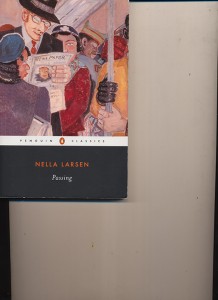Junior Olivia Whittaker reviews Nella Larsen’s novel “Passing”

PHOTO BY COURTNEY LE
Despite the difficulty one of modern times would face in reading a novel about the struggles of racism in harsh 1920s Chicago and Harlem and in placing themselves in such a time period, taking the time to read Nella Larsen’s “Passing” is well worth the task.
“Passing” is promising, engulfing and abundantly thoughtful—the kind of novel that subconsciously forces us to stop and muse over the world and reminds us how thankful us 21st century Americans are to live and be born in such a contradictory era with analogous attitudes and perceptions to match.
The novel speaks about something still relevant in 21st century America: race. Even a century later in the welcoming Student Diversity Board forums of our exceptionally diverse school, students, as well as the majority of Americans, are timid to talk about race.
Larsen, “the Harlem Renaissance’s premier woman writer,” tells the seemingly contradictory—yet, virtually identical—stories of two women, former childhood friends, Irene and Clare, in their struggles involving race, heritage and the act of passing in a “remarkably candid exploration of shifting racial and sexual boundaries,” as stated in “Passing.”
Though Larsen’s readers could take away many purposes from such a novel, perhaps one of her most resonating arguments was to show that race is truly a complicated thing. Larsen’s emotion-provoking characters and self-submerging scenarios, as well as her novel as a whole, have changed my perception and definition of race entirely.
Though race might literally be defined in the dictionary as a division of mankind on the basis of skin color, hair color, eye color, facial features, amid all other outward appearances, Larsen has shown me, as well as the rest of her readers, through the ever-changing motives of a nostalgic Clare, the internal conflict of race over self or self over race we directly endure with Irene, and her ultimate resolution to that conflict that it represents more.
Race is heritage and culture. According to The Bedford Anthology of American Literature, race is that irrepressible feeling of an “unremittent beat / made by cruel padded feet / walking through my body’s street” so vividly illustrated in Countée Cullen’s well-known poem “Heritage.”
Race, in Larsen’s “Passing,” examine[s] the role of culture in the shaping of identity and question[s] the dialogic between an African past and a European-influenced present for African-Americans” and serves as Larsen’s epigraph in the novel. Race is the abiding “allegiance to Clare” Irene experiences despite her acrimonious feelings towards her.
However, within the first few pages, the reader acknowledges the unrelatable, limited third-person narrator that Larsen establishes. This type of narration was new and exciting for me at first but became confusing. Throughout the novel, between the narrations and thoughts of an unrelated third person and Irene, I found myself biased and trapped in Irene’s insecure and envious perspective. For this reason, as a reader, I was unable to interpret and absorb the novel for what it was.
In addition, I found myself frustrated by the melodramatic cliffhanger of an ending Larsen offers. In conjunction with the unrelated third person narrator, the conclusion confuses and shocks the reader, taking away from the success of the novel, conflicting with the iconoclastic 1920s theory of modernism which altered literature to go against traditional views many found outdated for the emerging environment of an industrial world (“Modernism”), and distracting the reader from Larsen’s notable diction, description and unexpected relatability.
– Olivia Whittaker








